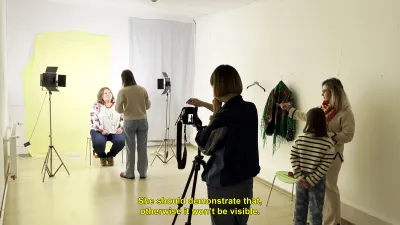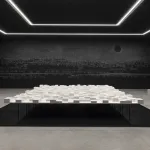
In the wake of Russia』s full-scale invasion of Ukraine, civilians seemingly mobilized overnight. Weaving camouflage nets to shield Ukrainian defenders became one of the urgent tasks. In church basements and museums, these volunteers twisted together strips of dark fabric and rags.
This action may seem like a smooth metaphor for a country coming together. But it disguised how complex this unity was, disuniform like the nets themselves—and how it has become even more so as the war stretches into its third year.
Titled 「Net Making,」 the Ukrainian Pavilion at this year』s Venice Biennale explores this tension. Ukrainians are connected by the shared reality of war, but that collective experience is felt and lived differently. It changes if you』re a soldier or a civilian. It changes if you』re a civilian living in Kyiv, or living miles from Russian-occupied land. It changes if you』re in Warsaw, or New York, separated from a friend or a father on the frontlines. There is no singular story of the conflict.
「Net Making」is also in dialogue with the theme of the Biennale』s main exhibition, 「Stranieri Ovunque – Foreigners Everywhere.」 Viktoria Bavykina and Max Gorbatskyi, the husband-and-wife team who curated the Ukrainian Pavilion, said they wanted to show how war can turn people into strangers, causing a rift between those who』ve been directly affected by it and those who have not. 「In Ukrainian, [we say] inshuvannia, making someone other,」 Gorbatskyi told ARTnews.
That feeling of being othered changed how Ukrainians existed in the world, Gorbatskyi said. Identities shifted. Gorbatskyi and Bavykina, who also co-founded the online platform Ukrainian. Photographies in 2022 as a response to the war, said they wanted to capture this horizontality of Ukrainian society, and the changing roles people are taking on: artist to soldier, teacher to refugee, tech worker to drone maker. These roles remain fluid as people and communities are shaped and reshaped by each new phase of the conflict.

At the Arsenale, 「Net Making」 will be presented in an enclosure, designed by Oleksandr (Sasha) Burlaka, that is made from woven linens from Ukraine, dating back to the 1950s and earlier and sourced online and from flea markets. In making the metaphor of Ukrainians』 net-making during the war tangible, the architecture for the exhibition also doubles as a net connecting the three works featured in the Pavilion.
Andriy Rachinskiy and Daniil Revkovskiy』s nearly hour-long film, Civilians. Invasion (2023),takes on the war most directly, piecing together YouTube footage shot in the early days of Russia』s assault. Though countless images and videos of the war in Ukraine have circulated on social media, Rachinskiy and Revkovskiy sought videos on private and public channels that had tiny view counts, offering new and different vantage points of the conflict. Shelling is seen from the view of one apartment balcony, while a person』s escape out of a city is shot through the frame of a car window, the viewfinder shaking. They narrate breathlessly, keeping the camera rolling even as they』re unsure of what they』re recording, or how it might end. (The film is subtitled in Ukrainian and English.) Rachynskyi described it as a 「selection and visualization of the collective memory of Ukrainians—those who survived the occupation and those who did not.」

While Civilians. Invasion tells the story of those living in Ukraine, Comfort Work (2023–24) by Andrii Dostliev and Lia Dostlieva is its foil, exploring the experience of Ukrainian refugees. For their contribution to the Pavilion, the husband-and-wife team confronted the stereotypes of a supposed model refugee. Mothers with young children and the poor and struggling more often fit the narratives about who is deserving of help, the artists seem to say. To create the work, which consists of short videos with European actors playing the roles of Ukrainian refugees, Dostliev and Dostlieva conducted interviews with displaced people and hired Ukrainian refugees to serve as mentors on set. Dostliev said this shifted the power structure, as Ukrainians directed the actors on how to behave. The Ukrainian participants also had fun during this process, Dostlieva said, which itself subverted the idea of how people who have fled a war zone should act.
The Ukrainian Pavilion also considers how catastrophe more broadly transforms language. Kyiv-based artist Katya Buchatska』s project, Best Wishes, looks at how the invasion made certain words or everyday conversation—asking about weekend plans or wishing someone a happy birthday—feel imprecise and insufficient. Bringing together work from 15 neurodiverse artists, Best Wishes evokes the future, something otherwise difficult to think about amid war. That makes it a powerful act, she said, and an important one to bring to the Biennale.

This year』s Ukrainian Pavilion contrasts to the shock of Russia』s invasion two years ago in which artists and curators scrambled to create responses to it, both in Venice and beyond. Now, the crisis feels more permanent, and even more uncertain, a reminder to the world to look again. 「The war is not over, it is not on pause,」 Rachkinsky, the Civilians. Invasion artist, said.
That distance from the war』s start further complicates what it is like to live through a war. Buchatska, of Best Wishes, said the exhibition broadly reflects Ukraine』s many layered realities in one. 「I find that our Pavilion is like that,」 she said. 「Sometimes you really can』t understand why all these artworks are together. But it』s literally how I feel myself in Ukraine now. Because there you have bomb shelling, but here you have [a] party.」
The varied and at times unequal experiences of Ukrainians witnessing the war recurs in other works of Ukrainian artists appearing in 「From Ukraine: Dare to Dream,」 a collateral event presented by the Kyiv-based PinchukArtCentre (on view April 20–August 1). The presentation features both Ukrainian and international artists, newly and previously commissioned work, as well as some historical pieces. Curated by Björn Geldhof, Ksenia Malykh, and Oleksandra Pogrebnyak, this exhibition connects Ukraine to the consequences of conflict and displacement around the globe, with an eye toward imagining how these forces might shape the future.
The curators said few of the works are an immediate or direct comment on war. 「It stays away from that,」 Geldhof said. 「Of course it』s present because we wouldn』t want to escape from reality. But it』s not the singular anchor point of this exhibition.」

And that is a challenge many Ukrainian artists face. Before the war, Butchaska said, you did the art you wanted, without thinking of the viewer. 「And now you start to think your identity just became a war artist from the war country, and that [you] should witness it.」 It has turned artists into archivists, Gorbatskyi said.
With his collaborator Roman Khimei, Ukrainian artist Yarema Malashchuk created two works that will feature in the PinchukArtCentre show. One explores the tension between civilian and soldier; the other is a multichannel video that shows formerly kidnapped Ukrainian children as they sleep. Malashchuk said it would be a great privilege to do something unrelated to war, but he also doesn』t see how it is possible. 「What does it mean: work about the war?」 he asked. 「It can be everything, you know.」
「Even if you paint a vase, and [it』s] entitled Kyiv, Ukraine 2022, 1st of April, it would be a work of war,」 he added, pointing to a day some five weeks after the invasion began. 「Because what would you have been doing, on the first of April in Kyiv, painting vases?」
